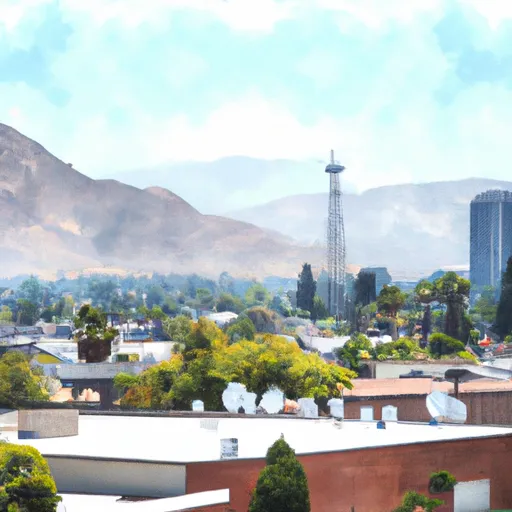-
 Snoflo Premium
Snoflo Premium
Get unlimited access to all our content
With no Ad interruptions! - Start Your Free Trial Login with existing account
Riverside
Eden Index
Climate
8.7
•
Recreation
4.5
•
Community
2.7
•
Safeguard
5.7/10

Riverside, California, located in the heart of the Inland Empire, offers a diverse climate, hydrology constituents, and an array of outdoor recreation opportunities. The city experiences a Mediterranean climate with hot, dry summers and mild winters. Summers often see temperatures rising above 90°F (32°C), while winters are typically mild, with temperatures averaging around 60°F (15°C). Precipitation is limited, with the majority of rainfall occurring during the winter months.
Riverside boasts a rich hydrology system, as it is bisected by the Santa Ana River. The river provides a source of water and supports a variety of aquatic life. Additionally, the nearby Lake Mathews and Lake Perris offer further hydrological resources for the region.
Outdoor enthusiasts will find numerous recreational opportunities in Riverside. The city is home to several public parks, including the scenic Mount Rubidoux Park and Fairmount Park, both offering hiking trails, picnic areas, and beautiful views. The Box Springs Mountain Reserve is another popular spot for hiking, mountain biking, and bird-watching.
Overall, Riverside's climate, hydrology constituents, and outdoor recreation opportunities make it an attractive destination for those seeking a mix of outdoor activities and natural beauty.
What is the Eden Index?
The Snoflo Eden Index serves as a comprehensive rating system for regions, evaluating their desirability through a holistic assessment of climate health, outdoor recreation opportunities, and natural disaster risk, acknowledging the profound impact of these factors on livability and well-being.
Climate Health Indicator (CHI): 8.7
Riverside receives approximately
264mm of rain per year,
with humidity levels near 75%
and air temperatures averaging around
19°C.
Riverside has a plant hardyness factor of
9, meaning
plants and agriculture in this region tend to thrive here all year round.
By considering the ideal temperature range, reliable water supplies, clean air, and stable seasonal rain or snowpacks, the Climate Health Indicator (CHI) underscores the significance of a healthy climate as the foundation for quality living.
A healthy climate is paramount for ensuring a high quality of life and livability in a region, fostering both physical well-being and environmental harmony. This can be characterized by ideal temperatures, reliable access to water supplies, clean air, and consistent seasonal rain or snowpacks.
Weather Forecast
Streamflow Conditions
Santa Ana
Area Rivers
Santa Ana
Snowpack Depths
Santa Ana
Reservoir Storage Capacity
Santa Ana
Groundwater Levels
Recreational Opportunity Index (ROI): 4.5
The Recreational Opportunity Index (ROI) recognizes the value of outdoor recreational options, such as parks, hiking trails, camping sites, and fishing spots, while acknowledging that climate plays a pivotal role in ensuring the comfort and consistency of these experiences.
Access to outdoor recreational opportunities, encompassing activities such as parks, hiking, camping, and fishing, is crucial for overall well-being, and the climate plays a pivotal role in enabling and enhancing these experiences, ensuring that individuals can engage in nature-based activities comfortably and consistently.
Camping Areas
| Campground | Campsites | Reservations | Toilets | Showers | Elevation |
|---|---|---|---|---|---|
| Ortega Flats - Caspers Wilderness Co Park | None | 388 ft | |||
| Wildomar | 11 | 2,456 ft | |||
| El Cariso | 24 | 2,568 ft | |||
| March ARB Military | None | 1,509 ft | |||
| Upper San Juan | 18 | 1,761 ft | |||
| Lake Perris State Rec Area | 351 | 1,600 ft | |||
| Blue Jay | 50 | 3,358 ft | |||
| Lake Elsinore | 400 | 1,286 ft | |||
| Live Oak - Caspers Wilderness Co Park | None | 387 ft | |||
| Caspers Wilderness Park | None | 387 ft |
Catastrophe Safeguard Index (CSI):
The Catastrophe Safeguard Index (CSI) recognizes that natural disaster risk, encompassing floods, fires, hurricanes, and tornadoes, can drastically affect safety and the overall appeal of an area.
The level of natural disaster risk in a region significantly affects safety and the overall livability, with climate change amplifying these risks by potentially increasing the frequency and intensity of events like floods, fires, hurricanes, and tornadoes, thereby posing substantial challenges to community resilience and well-being.
Community Resilience Indicator (CRI): 2.7
The Community Resilience Indicator (CRI) recognizes that education, healthcare, and socioeconomics are crucial to the well-being of a region. The CRI acknowledges the profound impact of these elements on residents' overall quality of life. By evaluating educational resources, healthcare accessibility, and economic inclusivity, the index captures the essential aspects that contribute to a thriving community, fostering resident satisfaction, equity, and social cohesion.

